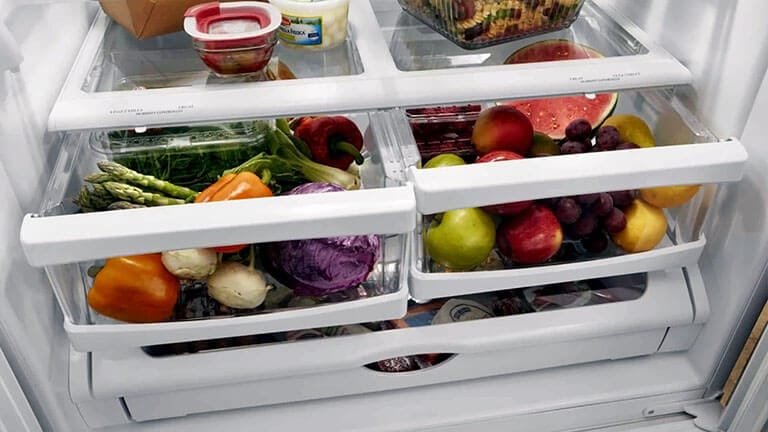Your Whirlpool fridge should be your trusty kitchen companion, keeping your food fresh and your drinks cool. But what happens when it suddenly stops doing its job?
If you’ve noticed that your Whirlpool fridge isn’t cooling, you’re likely feeling concerned and frustrated. You rely on your fridge to preserve your groceries, and when it fails, it disrupts your daily life and causes unnecessary stress. Imagine opening your fridge door only to find lukewarm milk or spoiling leftovers.
It’s a scenario you want to avoid at all costs. Luckily, understanding why your Whirlpool fridge isn’t cooling can lead you to simple solutions. By the end of this article, you’ll be equipped with knowledge that can restore your fridge to its optimal condition, ensuring your kitchen runs smoothly once more. Let’s dive into the common causes behind this issue and explore how you can fix them without hassle.
Common Causes Of Cooling Issues
Is your Whirlpool fridge not cooling? This problem can be frustrating, especially when your groceries are at stake. Understanding the common causes of cooling issues can help you identify and fix the problem quickly. Let’s dive into some typical culprits behind this cooling conundrum.
Thermostat Problems
The thermostat is like the brain of your fridge, regulating temperature and ensuring everything stays cool. If it’s malfunctioning, your fridge might not maintain the right temperature. Have you checked if your thermostat is set to the right level? Sometimes, accidentally turning it can cause cooling issues.
Try adjusting the thermostat settings to see if the cooling improves. If this doesn’t work, it might be time to replace it. A faulty thermostat can be a major stumbling block in keeping your food fresh.
Condenser Coil Blockages
Condenser coils play a crucial role in cooling by releasing heat. When these coils are clogged with dust and dirt, they can’t function effectively. Have you ever cleaned the coils at the back of your fridge? If not, this might be the root of your problem.
Grab a vacuum or a coil brush and give them a good clean. This simple maintenance task can significantly enhance your fridge’s cooling performance, saving you from potential food spoilage.
Faulty Evaporator Fan
The evaporator fan circulates cool air throughout the fridge. If it fails, parts of your fridge may remain warm. Listen closely—do you hear the fan running? If not, the fan might be broken.
Replacing a faulty evaporator fan is crucial for restoring proper airflow. Without it, even the best cooling mechanisms can’t do their job. Don’t let a small component cause a big headache.
Damaged Door Seal
The door seal keeps cold air inside and prevents warm air from entering. If it’s damaged, your fridge struggles to maintain its cool. Run your fingers along the seal—does it feel cracked or loose?
Replacing or repairing the door seal can be a quick fix. This small step ensures your fridge stays efficient and your food stays fresh. Why let a damaged seal sabotage your cooling efforts?
Are you ready to tackle these common issues? With these insights, you can make sure your Whirlpool fridge runs smoothly, keeping your perishables perfectly chilled.
Diagnosing The Problem
Finding out why your Whirlpool fridge isn’t cooling can feel like solving a mystery. It’s frustrating when your food doesn’t stay fresh. But don’t worry, diagnosing the problem can be straightforward if you know where to look. Let’s dive into some key areas you should check.
Checking Temperature Settings
Before you panic, ensure the temperature settings are correct. Sometimes, the dial can be nudged accidentally while cleaning or rearranging items. Set it to the recommended level, typically between 37°F and 40°F for the fridge. A simple adjustment might be all it takes.
Inspecting The Compressor
The compressor is like your fridge’s heartbeat. If it’s not working properly, the cooling will be affected. Check if the compressor is running. You might hear a slight humming sound. If it’s silent or making unusual noises, it might need professional help.
Assessing Airflow Blockage
Is your fridge packed to the brim? Overstocking can block the airflow, preventing proper cooling. Try rearranging items to ensure air can circulate freely. Leaving space around vents can make a significant difference in cooling efficiency.
Listening For Unusual Noises
Odd sounds can be a clue to your fridge’s problems. Listen closely. Is there rattling or clunking? These noises could indicate an issue with internal components. Fixing them early can prevent bigger problems down the line.
Have you ever solved a problem with your fridge by just listening to it? It’s amazing how much you can learn by simply paying attention. Is your Whirlpool fridge telling you something? Sometimes, all it takes is a bit of detective work to keep your fridge running smoothly.
Simple Fixes To Try
Whirlpool fridge not cooling? Check the thermostat setting first. Then, clean the condenser coils. Ensure the vents are not blocked. Simple steps can solve cooling problems.
If your Whirlpool fridge isn’t cooling, you might feel worried. Before calling a technician, try these simple fixes. They can save you time and money.
Cleaning The Coils
Dusty coils can make the fridge work harder. This reduces cooling efficiency. Unplug the fridge for safety. Locate the coils at the back or bottom. Use a vacuum or brush to remove dust. Clean coils help the fridge cool better.
Adjusting The Thermostat
Check the thermostat settings. Sometimes they get changed accidentally. Set the temperature to the recommended level. Too warm? The fridge won’t cool properly. Adjusting it back might fix the problem.
Replacing The Door Seal
A worn door seal lets cold air escape. This makes the fridge less effective. Check the seal for cracks or gaps. Close the door on a paper. If it slides out easily, replace the seal. A good seal keeps the cold air in.
Defrosting The Freezer
Ice buildup in the freezer can block airflow. This prevents proper cooling. Turn off the fridge and let the ice melt. Clean up any water afterward. Restart the fridge and check the cooling. A defrosted freezer often fixes cooling issues.
When To Call A Professional
Sometimes, a Whirlpool fridge not cooling needs a professional touch. DIY fixes might not solve complex issues. Knowing when to seek help saves time and money. This section helps identify situations needing expert attention.
Identifying Complex Repairs
Some fridge problems are tricky. Unusual noises or persistent cooling issues may signal complex repairs. If unsure about the root cause, it’s best to consult a technician. They have the skills to diagnose and fix intricate problems.
Recognizing Electrical Issues
Electrical problems pose serious risks. Flickering lights or tripped breakers indicate electrical faults. Attempting to fix these without knowledge can be dangerous. A professional ensures safety and a proper solution.
Evaluating Cost Of Repair Vs. Replacement
Repair costs can add up. If repair estimates approach the price of a new fridge, consider replacement. A technician can provide a cost analysis. This helps decide the most economical option.
Why Whirlpool Fridge is Not Cooling [Here is the Preventive Maintenance Tips]

Maintaining your Whirlpool fridge ensures it runs efficiently. Regular care can prevent cooling issues. Simple practices make a big difference. Follow these tips to keep your fridge in top shape.
Regular Cleaning Routine
Dust and debris can block air vents. Clean them often. Wipe down shelves and drawers. A clean fridge keeps cool better. Use mild soap and water. Avoid harsh chemicals.
Don’t forget the condenser coils. They collect dust too. Unplug the fridge before cleaning. Use a vacuum or brush to remove buildup. Clean coils help your fridge cool effectively.
Proper Storage Practices
Organize food for good air flow. Don’t overcrowd the shelves. Leave space for air to circulate. Use containers to avoid spills. Store similar items together.
Keep raw and cooked foods separate. This prevents contamination. Check expiration dates regularly. Discard old or spoiled items. A well-organized fridge cools more efficiently.
Monitoring Temperature Consistency
Check your fridge’s temperature often. It should be between 37-40°F (3-4°C). Use a fridge thermometer for accuracy. Adjust the thermostat if needed.
Listen for strange noises. They may indicate a problem. Address issues quickly. Consistent temperature keeps food fresh longer.
Frequently Asked Questions
Why Is My Whirlpool Fridge Not Cooling Properly?
Your fridge might have dirty condenser coils. Clean them to improve cooling efficiency.
How Do I Fix A Whirlpool Fridge That’s Not Cooling?
Check the temperature settings. Ensure they’re correctly set. Also, clean the condenser coils.
What Causes Whirlpool Fridge Cooling Issues?
Common causes include blocked air vents, dirty coils, and faulty thermostats. Ensure proper airflow and clean coils.
Can A Faulty Compressor Affect Fridge Cooling?
Yes, a faulty compressor can cause cooling problems. It is vital for the refrigeration cycle.
Is A Whirlpool Fridge’s Cooling Affected By Overloading?
Yes, overloading can block air vents. Ensure vents are clear for proper air circulation.
Conclusion
A Whirlpool fridge not cooling can be frustrating. Check the thermostat settings first. Clean the condenser coils regularly to ensure efficiency. Make sure the fridge door closes tightly. Examine the evaporator fan for any faults. Defrost the freezer if there’s frost buildup.
Call a professional if these steps don’t help. Regular maintenance prevents future cooling issues. Keep your fridge running smoothly with these simple tips. Enjoy a consistently cool fridge and fresh food.
